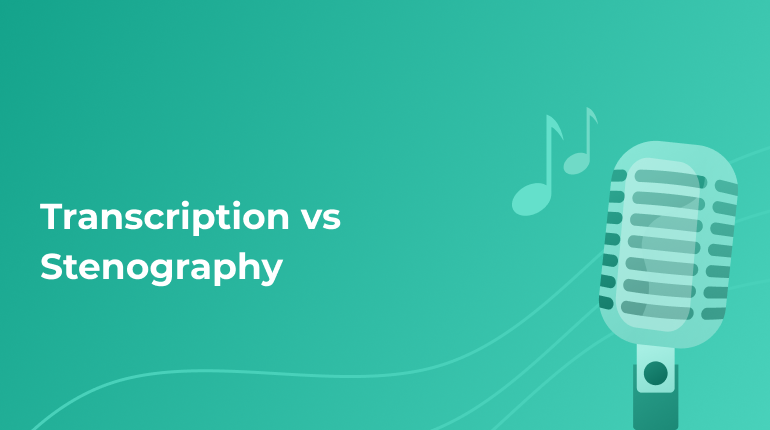Tips on Stenography vs Transcription & Cryptic Code vs Plain Language

People have invented different methods to transform audio into the written text. You can come across various names that refer to types of language recording. These are transcription, stenography, which correspond to a cryptic code and plain language.
All these notions are a part of what we call communication. But what is the difference between them? Let’s take a closer look at their discrepancies and similarities. Why do you need it?
- Being a student, you may need more profound knowledge about all these transcription processes. When you get a better understanding of what are the specific peculiarities of the notions, it will be easier for you to deal with them.
- Another thing touches upon the curiosity. You may not need a better comprehension for your professional life. But being able to differentiate these things is a great contribution to your outlook.
Let’s describe each of the terms and see how they differ. You will find this article interesting, so make sure to read to the end.
Stenography and Transcription: Why Should You Differentiate Them?
These two concepts sound similar. You may even think that they have the same features and are used in the same environment. But that’s not true. Being able to get the idea of these two principal notions will make you a real erudite.
Stenography
This word is a bit tricky. Have you ever heard about it? If you know the word, you may have heard about it during court hearings in the movies. Or you may learn it from parliament sessions that occurred years ago. It is still used in the academic context and can be present as a part of some summit negotiations. But stenography is a concept developed years ago.
Is it still present these days in our life? For sure, you can deal with stenography in many different spheres. In some cases, the process can be transformed and adjusted to the reality of our modern world. But the main concept remains the same.
What is stenography, and why is it associated with the cryptic code? When dealing with stenography, the specialist works with his hands to ensure correct writing or uses a specific machine. In most cases, people without specific knowledge can hardly manage such a complex undertaking. This is a tiring job. You need to record what other people say verbatim.
How can you read the message written in the form of stenography? This is usually done at a great speed with the use of tricky symbols, techniques, and methods. Who can manage the reading and get the idea? Only an expert can decipher the cryptic code made by the writer.
Why is it difficult to work with the text that has been coded? The main reason is the number of possible code variations. The number of shorthand systems is huge. Each writer and transcriber engaged in stenography uses its characters for depicting different phenomena of the speech.
Transcription
Here we deal with less demanding practice. When transcribing the text, you may have more time to process the information. Furthermore, you don’t usually need to record every single detail of the speech. Your task is to render the major points using the regular speech of the speakers.
Transcription is more popular because it can be performed easier. Furthermore, everyone can get acquainted with the text and get the writing’s main idea since plain language is used.
Differences Between Transcription and Stenography
In the previous paragraphs, we have discussed the main notions characteristics of stenography and transcription. But let’s summarize the facts and compare them.
- When working either with the first or with the second variant, you need to deal with human speech. It is all about converting real-life speech into the written text.
- You need to type the words or write them down using a pen. Whatever method you use, you can’t avoid this recording routine.
- It is better to ask a professional to manage the process. Some people can do the work well. But if you need a transcript for professional purposes, you can’t go without an expert.
These are the most common things characteristic of stenography and transcription. And it is better to know about them before you become a part of the process.
Tips To Deal With Stenography
If you should perform a stenography or work with the final document, you need to keep in mind several things:
- First of all, dealing with stenography takes more effort. The only thing that you have in your memory. If you forget about a necessary thing, you won’t be able to ask for a repeat. This is why careful listening practice is necessary.
- Furthermore, decoding stenography writing always takes more time. You won’t be able to decipher the code at the same time as you can manage the transcript. So, make sure to have more time to work with the stenography.
Make sure to remember the difference between these two basic notions. These characteristics may help you improve your work and achieve better results.
Last Words
Being able to differentiate stenography and transcription is a great skill. You can benefit a lot when you know which type of shorthand is to use. In many cases, you will need to deal with both of the notions. So, it is better to understand what they stand for.
Need Extra Help With Transcription?
You know why a high-quality transcription is helpful for your professional purposes. But have you already found the best service to manage transcripts? We can offer you a perfect tool to cope with your transcription practice.
Our immaculate service has already helped tons of customers. And you can be the next to benefit from the transcribing service. So, make sure to try the impressive quality of our transcription tool.
